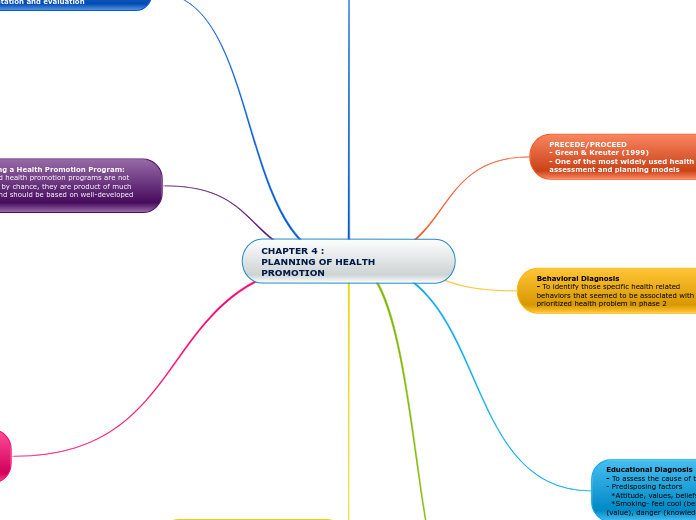CHAPTER 4 :
PLANNING OF HEALTH PROMOTION
Phases
- Implementation
*Planners select the methods and strategies of the intervention
PRECEDE/PROCEED
- Green & Kreuter (1999)
- One of the most widely used health assessment and planning models
Nine (9) phases :
- Social Assessment
- Epidemiological Assessment
- Behavioral & Environmental Assessment
- Educational & Ecological Assessment
- Administrative & Policy Assessment
- Implementation
- Process Evaluation
- Impact Evaluation
- Outcome Evaluation
Behavioral Diagnosis
- To identify those specific health related behaviors that seemed to be associated with the prioritized health problem in phase 2
Educational Diagnosis
- To assess the cause of the health behaviour
- Predisposing factors
*Attitude, values, beliefs, knowledge
*Smoking- feel cool (belief), accepted by peers (value), danger (knowledge)
Enabling factors
- Reward or encouraging feedback (+ve or -ve)
- smoking : encouraging by peers
Reinforcing factors
- Resources and skills needed for behavior change
- Exercise : safe and convenient place - improper exercise can cause muscle soreness and injury
Social Diagnosis
- Quality of Life (QOL)
- To determine the QOL as defined by social problems in the target population (illegitimacy, welfare, unemployment, absenteeism and crime)
Health educators' responsibilities are involved in some way with planning, implementation and evaluation
Planning a Health Promotion Program:
- A good health promotion programs are not created by chance, they are product of much effort and should be based on well-developed models
Importance using a mode;
- Models are means by which planners give structure and organization to the programming process
- Models provide planners with
- Direction and supply a frame on which to build
Example of types of planning models for health education/promotion program:
- PRECEDE (Green et al, 1980)
- PRECEDE/PROCEED (Green & Kreuter, 1991)
- MHEP (Ross & Mico, 1980)
- CHEM (Sullivan, 1973)
- MHEPRD (Bates & Winder, 1984)
- GHFDS (Patton et al , 1986)
- PATCH (Green & Kreuter, 1999, CDC1983)
PRECEDE:
- Green, Kreuter, Deeds & Patridge (1980)
- Acronym for Predisposing, Reinforcing and Enabling Causes in Educational Diagnosis and Evaluation
Four disciplines:
- Epidemiology
- Social/behavioral sciences
- Administration
- Education
7 phases:
- Social Diagnosis
- Epidemiological Diagnosis
- Behavioral Diagnosis
- Educational Diagnosis
- Educational Diagnosis (continue)
- Administrative Diagnosis
- Evaluation
